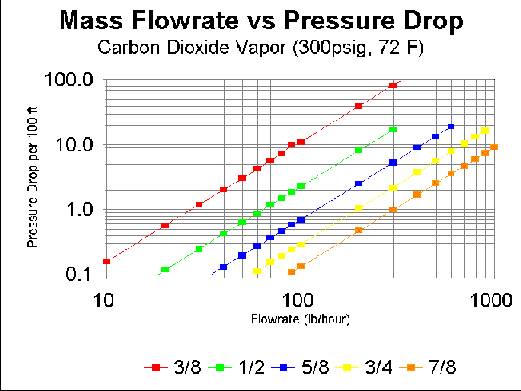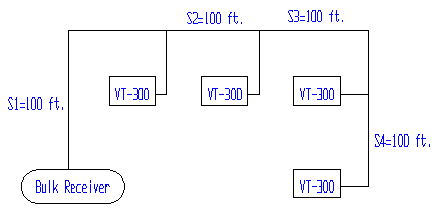

VAPOR
LINE DESIGN
FOR
VT-300 CO2
VAPOR
DISTRIBUTION SYSTEMS
Vapor distribution systems are
easily designed for almost any installation. Two factors must be
considered. 1) The system must be designed to safely handle the 300
psi pressure of the CO2
to be distributed. 2) There must be minimal drop in pressure due to
vapor flow at the satellite to be served.
No Insulation: A
CO2
vapor distribution system does not have to be insulated because the
CO2
vapor rapidly attains ambient temperature after leaving the bulk
CO2
storage tank receiver. Uninsulated vapor distribution lines remain
clear of condensation and icing whenever
CO2
vapor is being transferred to the satellite reservoir.
Line Material: Dry
CO2
vapor is inert so the choice of pipe or tubing is dependent only on
pressure ratings. Copper tubing is readily available, inexpensive,
light and very workable. For these reasons it is the primary choice
in most VT-300 CO2
vapor distribution systems.
Pressure Ratings: Copper
tubing for refrigeration and air conditioning use has pressure
ratings sufficiently high for bulk CO2
vapor use. The table below gives the rated internal working pressure
for several sizes of refrigeration tubing.
Rated Internal Working
Pressure for Type ACR
Annealed Copper
Tubing
|
Nominal Size
|
Wall
|
1000F
|
2000F
|
3000F
|
|
3/8
|
(.030)
|
900 psi
|
880 psi
|
740 psi
|
|
1/2
|
(.032)
|
740 psi
|
730 psi
|
610 psi
|
|
5/8
|
(.035)
|
740 psi
|
720 psi
|
610 psi
|
|
3/4
|
(.042)
|
650 psi
|
630 psi
|
530 psi
|
|
7/8
|
(.045)
|
590 psi
|
570 psi
|
480 psi
|
|
1-1/8
|
(.050)
|
510 psi
|
490 psi
|
420 psi
|
|
1-3/8
|
(.055)
|
460 psi
|
440 psi
|
370 psi
|
|
1-5/8
|
(.060)
|
430 psi
|
410 psi
|
350 psi
|
Pressure Ratings and Burst
Pressures: The pressure ratings above have been determined using
an allowable stress that is a small fraction of copper's ultimate
tensile strength. The actual burst pressure is many times higher than
this, for example the measured burst pressure the 1/2" tube is 5900
psi.
Joining Tubing sections: The
vapor system may be assembled using compression fittings, or
permanently with solder-type fittings. If solder type fittings are
used, use a brazing alloy or 95-5 Tin-Antimony solder do not use
soft solder . A tin-lead 50-50 solder provides a joint with a
pressure rating of only 200 psi.
Line Pressure Drop: Whenever
CO2
vapor flows through a pipeline a pressure drop occurs due to friction
loss. The magnitude of the drop is dependent upon the velocity of the
flow, and the size and physical properties of the pipe. The velocity
of the CO2
vapor is proportional to the rate of recondensing in the VT-300 units
in pounds of CO2/hour.

Allowance for Bends and Elbows and
Tees: Flow disturbances that occur at tube fittings add to the
pressure drop substantially. For instance, an elbow on a 1/2" line is
equivalent to about one foot added to the length. For a one inch
diameter, add two feet to the length. The proper factors must be
considered when laying the system out.
Peak Flow Rate for Small
Systems: In small systems with only a few VT-300
CO2
Satellite reservoirs, the possibility that all satellites are
recondensing at the same time is high. The peak flow rate should be
used for design and calculated by adding the condensing rates of all
of the satellite reservoirs. For example, a system with four VT-300-7
CO2
Satellite reservoirs would have four times the 20 pounds/hr flow rate
for a single unit or 80 pounds/hr.
Peak Flow Rate For Large
Systems: In large systems the probability of all stations
condensing CO2
simultaneously is low enough to safely assume that only a fraction of
the units will be recondensing at any time. If the maximum flowrate
is assumed, the system will probably not need to be modified if more
VT-300 CO2
Satellite Reservoirs are added.
Acceptable Pressure Drop: A
pressure drop of 10 or 15 psi is acceptable for satisfactory
operation of the VT-300 satellites reservoirs and the environmental
chamber solenoid valves. The pressure at any satellite is the source
pressure less the pressure drops in all segments supplying it. Select
segment pressure drops sufficiently low, so that when added together
the sum is less than 15 psi at all satellites.
Calculating Pressure Drops: In
a single piping system with satellites spaced along it, add the
average recondensing rates of all satellites to determine the
flowrate in the first segment of the piping. The next section of pipe
will have the mass flowrate of the first section less the recovery
rate of the first satellite. The last section of the piping system
would only have the flow-rate of a single VT-300. The average
condensing rates for VT-300 CO2
Satellites are listed on the VT-300 price list.
Designing Trunk Lines: To
determine the required pipe sizes for the system with branches start
at the CO2
receiver and select a tubing size to accommodate the total mass flow
for the system. Add up the average recovery rates for all of the
VT-300 Satellite reservoirs. Using the pressure drop table select a
tubing size that gives a pressure drop of 5 psi or less.
Designing Branch Lines:
Calculate the pressure drops of branch lines by adding the average
recovery rates of all VT-300 units on the branch. Smaller diameter
tubing may be used since there are fewer VT-300
CO2
Satellite Reservoirs on a branch than a trunk. Generally two tubing
sizes will satisfy the needs of an entire system. Each successive
segment will have a lower pressure drop per 100 feet because the mass
flow rate is reduced as each reservoir is passed. The total pressure
drop at the end of any branch line should not be more than 15 psi
under full flow condition.
Typical Calculation: Four
VT-300-7 CO2
Satellite reservoirs, each with an average condensing rate of 20
pounds of CO2
per hour are fed from a line 500 feet long. The units are spaced 100
feet apart with the first VT-300-7 200 feet from the
CO2
receiver.

Diagram
1
The mass flowrate in the first
segment is 80 pounds per hour because all four VT-300-7
CO2
Satellites draw CO2
vapor through the first line segment. Referring to the graph, it is
apparent that 0.5" OD tubing with a 1.7 psi/100' pressure drop is the
minimum pipe diameter. The next size smaller tubing shown (0.375")
has an unacceptable pressure drop of almost 8 psi/100'. The total
pressure drop in the 200' first segment is 3.4 psi.
The second segment will have a flow
rate of 60 pounds per hour because the first VT-300-7
CO2
Satellite has been passed. From the graph it is apparent that the
tubing still must be 0.5" OD which has a pressure drop of about 1 psi
for the 100' segment.
The third segment will have a flow
rate of 40 pounds per hour with the load of the two remaining
VT-300-7 CO2
Satellites remaining. The next size smaller tubing now can be
selected because 0.375" OD tubing only has a drop of 2.11 psi per
hundred feet at 40 pounds per hour.
The last segment with only the flow
rate of the last VT-300-7 CO2
Satellite would have a pressure drop of less than 1 psi. for 0.375"
OD tubing. The total pressure drop between the receiver and the last
reservoirs would be the sum of the drops for each segment, 3.4 + 1.0
+ 2.11 + 1.0 =7.51 psi. The total pressure drop of 7.51 psi is well
within the 15 psi specified limit.
From a practical view point, it is
likely that a single size of tubing will be used. This is a wise
choice because it allows for future expansion of the vapor
distribution system.

Home
Cleaning Systems
|
Dry Ice
Cleaning
|
Steam
Cleaning
|
Supersonic
Cleaning
CO2
Purification
Component/Parts
Cooler
|
Economical Cooling
System
|
CO2 Satellite Reservoirs
Contact Va-Tran
|
Technical
Information


677 ANITA STREET, SUITE A, CHULA
VISTA, CALIFORNIA 91911
phone: 619/423-4555 toll free 800/379-4231 fax:
619/423-4604
Copyright 1998, Va-Tran Systems
Incorporated.
Webmaster



